What happens if you urinate on an electric fence? We find out the answer to this and some of your other science questions on this week's Naked Scientists, including why chilli peppers are red, how does squinting help you see further and what's the best way to align your laundry with the wind? Plus, why blue food colouring could reduce the damage of spinal injury, how shrimps could catalyse biodiesel production and the physics behind the regularity of raindrops...
In this episode

- How do we actually make money out of open source?
How do we actually make money out of open source?
Chris - Interesting question, don't know if anyone has any thoughts about this software which basically companies are not charging for. They're made available freely. How do they actually have a model which is going to sustain that software and make any revenue? I mean you use a lot of this stuff, Dave, in what you do. What do you think the answer is?Dave - It's hard to make as much money as you would do by selling stuff but the various people who have models whereby they sell support the software so if you want it changed and customised for your thing then they'll charge for that sort of thing. But, yeah, generally, it is a big problem.
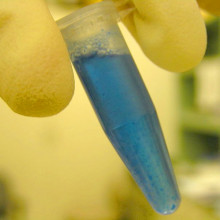
Food dye at the spinal frontier
Scientists have discovered that a dye used to colour food can also help to heal spinal injuries. Writing in this week's PNAS, a team at the University of Rochester led by Maiken Nedergaard describe how a dose of Brilliant Blue G, an analogue of the food dye FD&C blue dye No. 1, can help rats with cord injuries to recover better than controls. The effect, say the team, is down to the ability of the dye to block a class of nerve transmitter receptors known as P2X7 receptors, which are present on spinal nerves and respond to chemical signals called purines, including one called ATP. Purines are released in large abundance during spinal injuries.
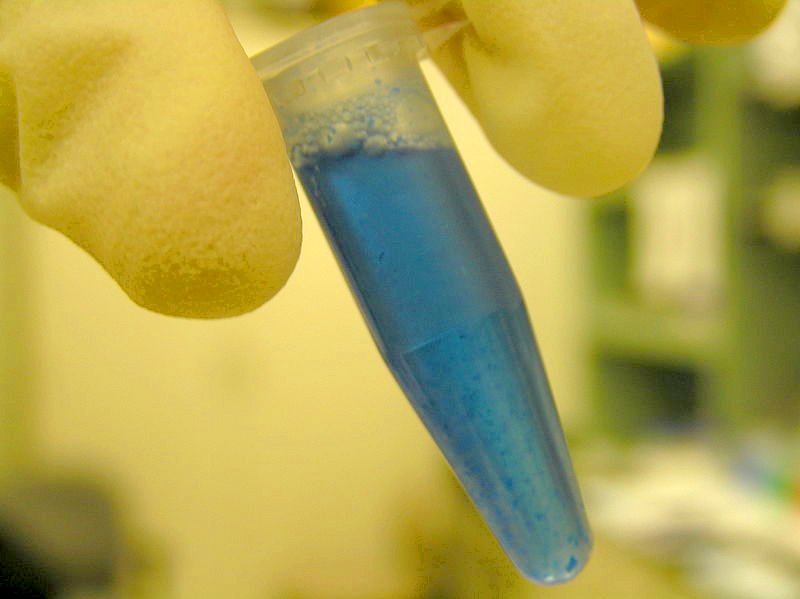 When they lock onto P2X7 receptors a large pore is formed on the target nerve cell which allows large amounts of calcium and other potentially toxic substances to enter and kill the cell. This contributes significantly to what is known as "secondary damage" that often follows an injury and is responsible subsequently for a significant disability. The team had previously identified a chemical capable of blocking P2X7receptors, OxATP, which had shown promise in reducing spinal cord injury but it was highly toxic to other tissues, ruling out any therapeutic role for the agent. But this prompted the team to look for other substances capable of doing the same job, leading them to Brilliant Blue G (BBG). To test its effectiveness the team subjected experimental rats to spinal cord injuries.
When they lock onto P2X7 receptors a large pore is formed on the target nerve cell which allows large amounts of calcium and other potentially toxic substances to enter and kill the cell. This contributes significantly to what is known as "secondary damage" that often follows an injury and is responsible subsequently for a significant disability. The team had previously identified a chemical capable of blocking P2X7receptors, OxATP, which had shown promise in reducing spinal cord injury but it was highly toxic to other tissues, ruling out any therapeutic role for the agent. But this prompted the team to look for other substances capable of doing the same job, leading them to Brilliant Blue G (BBG). To test its effectiveness the team subjected experimental rats to spinal cord injuries.
Some of the animals received BBG whilst others were left untreated as controls. The researchers found that the BBG-treated animals began to recover sooner than the controls and regained superior function subsequently. And when the team compared the spinal cord tissue from the animals they found that the treated rats had significantly less secondary spinal tissue loss than the controls. The team point out that given the proven safety record of BBG this strategy could make a significant contribution to the management of spinal and other central nervous system injuries. At present, they point out, steroids like methyl prednisolone are about the best that doctors can offer a spinal injury patient. Steroids have modest benefit and work by reducing inflammation at the injury site but there is a delay before they begin to work. The effect of BBG is instantaneous, say the scientists, so it could have much to offer...
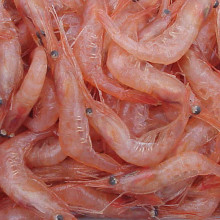
Put a shrimp in your tank
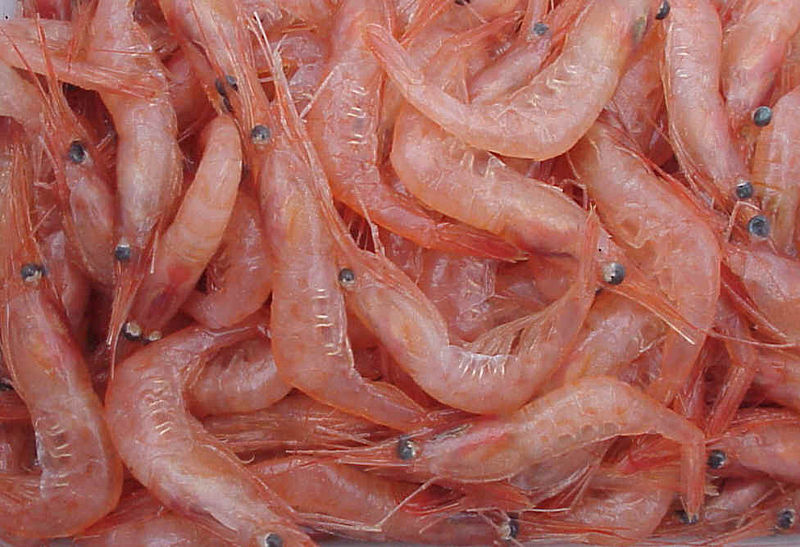 You've heard of putting a tiger in your tank, but now how about putting a shrimp in your tank? Doesn't sound quite so impressive does it? But, that's exactly what scientists in China have been doing in an attempt to make biodiesel production more efficient.
You've heard of putting a tiger in your tank, but now how about putting a shrimp in your tank? Doesn't sound quite so impressive does it? But, that's exactly what scientists in China have been doing in an attempt to make biodiesel production more efficient.
XinshengZheng and colleagues from HuaZhong Agriculture University in Wuhan have discovered that shrimp shells could be a great improvement on the catalysts currently used to convert natural oils - from crops like soya,sunflowersand rapeseed - into diesel fuels for vehicles.
The use of biofuels is fraught with controversy. One possible way to get closer to a sustainable source of renewable fuel is to improve the yield of fuel per acre of crop.
Making biodiesel involves a process known as transesterification, which is essentially changes the chemical makeup of fatty acids in seed oils to convert them into a useable fuel. The reaction normally takes place very slowly, if at all, with the addition of a simple alcohol like methanol.
Traditionally it is speeded up and made more efficient by adding a catalyst in the form of a strong acid or base. The problem with these acid and base catalysts is they can't be reused and they involve the use of lots of water, another limited resource.
Now it seems shrimp shells could provide an alternative, more efficient catalyst that can be reused and doesn't need masses of water. Shrimp shell is made up mostly of chitin, the same stuff that our nails and hair are made of. By carbonizing - or burning - the shells and adding potassium fluoride,Zheng and the team made a catalyst which, after 3 hours, converted 89% of samples canola oil into biodiesel.
Shrimp shell make aparticularly good catalyst because is it's complex porous structure with dense honeycomblayers. With such a large internal surface area to the shell fragments there are lots of sites the oils come into contact with and where theesterification reaction will be speeded up, making the conversion to alcohol quicker and more complete.
The authors of the study, which appears in the journal Energy and Fuels, point out that shrimp shell is biodegradable and cheap, being a bi-product of the seafood industry. And while no-doubt the diofueldebate will rage on, they think this new finding could prove to be an important breakthrough in making biofuels more efficient and perhaps a bit less controversial.
Paper: Yang, L, Zhang, A., Zheng, X. 2009. Shrimp shell catalyst for biodiesel production. Energy & Fuels.
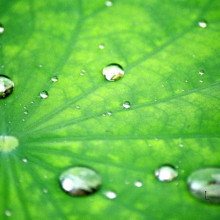
Raindrop sizes explained
In the nineteenth centuary scientists studying the weather looked at raindrop sizes, and discovered something quite interesting. There was quite a variation, most were less than 1mm across but a few were up to 5mm across, but for the same rate of rainfall the distribution was always the same.
This is strange as there are lots of ways in which rain can be created, at different heights and rates, depending on the clouds it is coming from. At the time it was thought that it was because big drops were crashing into one another and breaking apart. The problem is that there just aren't enough raindrops in the sky to crash into each other so scientists have remained confused.
Emmanuel Villermaux at Aix-Marseille University has probably worked out what is going on. There is a well known effect on fast moving droplets of diesel in an engine, where they flatten, then blow up to form a parachute shape and then pop to form smaller droplets.
This is an effect I noticed on a high speed video of our
water rockets kitchen science experiment. right at the end of this video, watch the last water droplet falling.
So they did some experiments and discovered that the distribution of droplets coming from one of these bubbles is exactly what you find in raindrops, so this may solve the century old mystery.
They have yet to see this process occurring with raindrops, put they are flying high speed cameras on planes looking for the events.
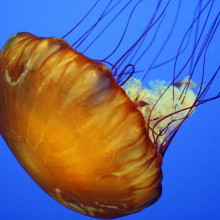
Jellyfish stirring things up.
Jellyfish may spend their lives passively drifting through the open oceans at the mercy of currents and tides, but they could also be stirring things up as they go.
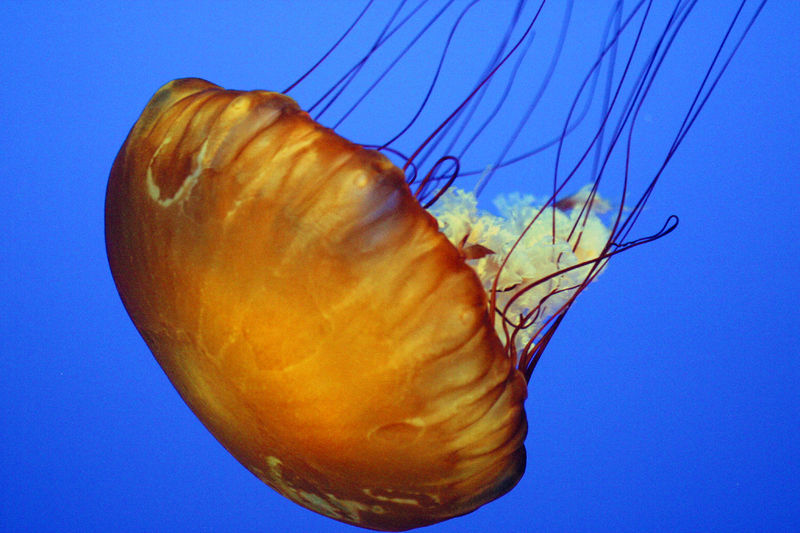 Together, all the swimming things in the oceans - including minute plankton - could contribute as much mixing as the winds and tides. That's according to KakaniKatijaand JohnDabiri from the California Institute of Technology in Pasadena who's study appeared this week in the journal Nature. It could mean that climate modelers have been missing an important part of the puzzle.
Together, all the swimming things in the oceans - including minute plankton - could contribute as much mixing as the winds and tides. That's according to KakaniKatijaand JohnDabiri from the California Institute of Technology in Pasadena who's study appeared this week in the journal Nature. It could mean that climate modelers have been missing an important part of the puzzle.
Katija and Dabiriused computer models to investigate a process in which a body moving through a fluid pulls some of that fluid with it. The more sticky or viscous the fluid is, the more of it is pulled along. This was an idea first reported 50 years ago by Charles Darwin - grandson of famous author of On the Origin of Species.
The computer models showed that a tiny plankton pulls up to four times its volume in water by just moving a few body lengths.
The research duo then set off for Palau, a cluster of beautiful tropical islands in the Pacific, to test out their ideas among swarms of real jellyfish: a very sensible choice because there jellyfish living in land-locked marine lakes have evolved to have no sting.
They squirted luminous dye behind of the jellyfish and filmed them using special laser-equipped underwater cameras. They watched as each jellyfish was followed by a trail of glowing dye. It turns out that up to 90% of the water movement came down to Darwin's theory and not because of a turbulent wake streaming behind the jellyfish.
The big question now is how this translates to a global scale, but there are important implications. A huge proportion of carbon dioxide emissions are absorbed by the oceans, both dissolving into the water and captured by planktonicplantlife. If animals swimming around are making a significant contribution to mixing up layers of the ocean this could be a major part of the climate equation that so far has been overlooked.
Oceanographer William Dewar writes an interesting commentary of this study in the same edition of Nature. He points how extraordinary it is that these processes acting at a tiny scale of mm and cm may have an affect on the vast oceans across hundreds of thousands of kms. Also, it is extraordinarily calm once you get down a short way into the oceans. All you would need is an electric kitchen hand-held mixer to stir up a cubic kilometer of sub-surface ocean. So, the jellyfish could be making a real difference down there.

13:13 - State of the art facility opens at the Babraham Institute
State of the art facility opens at the Babraham Institute
with Lord Drayson, Science Minister
Chris - Now, also on the news this week, the Babraham Institute, which is located just outside Cambridge, has opened a new laboratory, and so we sent Ben Valsler down there to attend the opening and also find out what was going on. He's with us to tell us a bit about it now. Hello, Ben?
Ben - Hello.
Chris - So what was this new centre about?
Ben - Well, this is the Institute's new Bioscience Support Unit. It cost £17 million to build and a further £5 million to equip. And it contains some state-of-the-art technology, including some funky robots that I was watching. The Babraham Institute itself researches various biological mechanisms - how they work, how they sometimes go wrong. And this gives us some insight into things like the causes of cancer, the causes of heart disease and actually the way that we age as well. Now this sort of research underpins development of new therapies and this new Bioscience Support Unit will not only make the research easier and more accurate and quicker but it's actually designed in such a way to be really flexible, which makes the whole thing future-proof and should secure that investment for a good while yet. The Babraham Institute itself is funded by the BBSRC, that's the Biotechnology and Biological Sciences Research Council. They get their money from the UK government and Lord Drayson, who's the science minister, was there to open the unit. Twenty-two million pounds is a lot of investment especially during a financial crisis like this one but he believes that science is a priority.
Lord Drayson - Science is vitally important to the UK, in part, because one has to ask the question, given the way in which the world is developing, given the UK's position in 2009 in that world, what are the things which the UK is going to be particularly good at? What is it we're going to earn our living in, as a country? And the answer to that has to be science and the commercialisation of science, in terms of innovative new products and services. We can't succeed as a nation by competing on this, if you like, low-tech side of life. Our contribution has to be from those areas where the intellectual contribution that the in-depth understanding that we have shown over the decades Britain is particularly good at, is our future. So my job as Science Minister is to raise the profile of science, to make heroes out of scientists and science entrepreneurs; to get the general public, who sometimes see science as a bit of an elitist endeavour,  something that is done by a group of brainy people but it doesn't really affect them; to understand that we, as a nation, have to be both scientifically literate, because science is going to be so important to our futures, but also comfortable in discussing some of the big issues in science. And if we can do that, we can continue being a world leader in science and if we maintain our position as world leader in science, we will have probably the happy and prosperous society.
something that is done by a group of brainy people but it doesn't really affect them; to understand that we, as a nation, have to be both scientifically literate, because science is going to be so important to our futures, but also comfortable in discussing some of the big issues in science. And if we can do that, we can continue being a world leader in science and if we maintain our position as world leader in science, we will have probably the happy and prosperous society.
Ben - Lord Drayson also commended the Babraham Institute for engaging local schools and the wider community because having a future-proof research facility is only any good if we have a good supply of future scientists. He said that there's one clear way to stay competitive in science in the future...
Lord Drayson - Continue to invest in it and maintain our focus on excellence and making sure that we're maintaining a strong pipeline of young people coming through from the schools who get excited by science at school; that science enthusiasm maintained as they're growing up, studying at science universities and coming through to be the next generation of leading scientific researchers. If you can develop a sort of scientific approach to living life, of noticing things and asking questions: why is that like that? Even at the most, if you like, most mundane level.
I mean, the thing that fascinating me as the science minister is that when you get to meet really brilliant scientists it's often something early in their life that they noticed which actually got them switched on to science. The more we can get people to make that switch go on, the more likely we'll have a positive pipeline of young scientists coming to look forward and that's going to be very important to our success as a country.
Ben - So it now seems that doing Kitchen Science experiments with your children is both fun and it's patriotic! That was Lord Drayson at the opening of the Babraham Institute's new Bioscience Support Unit.
Chris - It's pretty impressive you've got to talk to him. I think it was fantastic.
Ben - I was quite honoured though and he was really nice and he was very down to Earth. I didn't get the impression that, you know, he was there to see the little people at the opening, but he was very much with us, very much supporting what they were doing, very much supporting science in the UK.
Chris - Thank you very much. That was Ben Valsler who went down to the Babraham Institute when they opened the new facility this week.
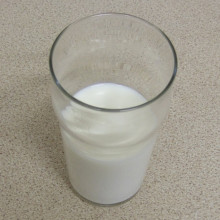
Can proteins eaten by a mother get into her breast milk?
Chris - Well, the answer is... I was intrigued by this (and my own observations at home) enough to want to look this up because my wife had been saying to me many times - because we now have two small children, both were breast fed - that when she ate certain things, it seemed to make the children more prone to getting a belly ache and have wind than when she ate other things. I said: "Well it's nonsense. It's coming in as breast milk." And, you know, how can that be affected by what the mum eats?So I've been having a poke around and there's a paper published in 1921; WR Shannon who found that proteins which are in the mother's diet that can pass unchanged into breast milk and there's another study which was done: Killshaw and Cant. They published in the International Archives of Allergy and Applied Immunology in 1984, and they did a very thorough study. They took 29 women who are breastfeeding. They took samples of their blood and their breast milk and then gave them an egg and half a pint of cow's milk to drink.Then they took samples of both of those blood and breast milk samples again, at various intervals afterwards. They measured the levels of these proteins and they used various measures to see whether the proteins where coming through into the breast milk. And they found that after the mother ate those things, they could pick up the egg and the milk proteins intact in her blood stream between 1 and 2 hours later and it peaked in breast milk 4 and 6 hours later. So this is really interesting. It shows things that are in the mother's diet can pass unchanged through into the baby and why they say that's important is because this may be a way in which the baby's immune system gets educated against the things that it will be eating in the future. Because we know that the babies when they are first born have this very plastic immune system that needs to be programmed what it has to recognize as a friend or what it needs to recognize as a foe. So this, perhaps, is why breast feeding is so important in helping the immune system get educated like this because the things are presented in the right context at the right time.Milk is made up mostly of water, globules of fat (yellow) and lumps of caesin protein called micelles. The micelles are covered with negative charge which repels other micelles. Ã?,© Dave AnsellHelen - Can it also be a problem? I think I have heard a story about in the Arctic, in fact, that some of the Inuit women there who eat a lot of whale meat, their breast milk becomes what's classified as contaminated waste. Some of the contaminants inside the whale meat; things like the mercury that build up in those animals living in the sea comes out in her breast milk to the point that it can be measured and it might be even damaging to their offspring, which is just disastrous. The idea that the environment is so contaminated and it's getting through our own systems. Isn't there also a story about if you have a dram of whisky that it calms down the mother and the baby.Chris - Now this is definitely true.Helen - I don't think we necessarily condone that but...Chris - But the way breast milk gets made is that there are specialised cells in the breast tissue which have a very high blood flow. The blood goes pass the breast cells; the cells remove from the blood various chemicals and concentrate them in milk. So they're using chemicals that come out of the blood, water from the blood and they're making milk. Anything that dissolves well in fat can move well through the blood vessel wall through those cells and into the ducts that line the breast. So therefore drugs and other things like alcohol can end up getting concentrated in breast milk so women have to be a bit careful when they take certain drugs because they can concentrate in the breast milk. And what she says about people who eat a diet which may be contaminated, of course there's a risk but, you know, we didn't evolve to combat heavy metal poisoning. We evolved to give our children the best start in life. So, I guess, the kind of that is unfortunate side-effect but the bottom line is breast actually best for the most part.Helen - Oh yeah, absolutely, yeah..

If you urinate on an electric fence will it shock you?
Dave - I can't say any reason why not and I grew up in a rural area, and it was one thing I was told very, very definitely not to do, with such force. I have a feeling various groups that were telling me had personal experience in this area.
An electric fence, basically, works by having a wire which is put up to a couple of thousand Volts with a very limited current. So the current will flow through you, but the amount of current that can flow is not going to be dangerous.
Now, an electric current will flow quite well through your body because your body's got water in it with some salt in there. The salt has got ions in it which means the electricity can flow through it quite nicely. Urine is water with some salts in it so electricity is going to flow through it very nicely. So, yes, as far as I know, you can certainly get shock in that manner, yes.
Chris - Is that true where the guy pees on the underground and gets a bit of a shock? Would it be fatal? Would there be enough current flowing in the urine stream, do you think, to get...?
Dave - I don't know. The underground is about 600 volts, I think, which...
Chris - DC?
Dave - DC. So I would have thought that this will be plenty there. Again, it depends how well where the current can flow, if he's attached to earth quite nicely. If he's wearing rubber Wellington boots, probably less likely.
Chris - And will the electricity flow up the urine at the speed of light - i.e. the speed electricity?
Dave - It should flow up the urine at about the speed of electricity, yes.
Chris - So it would be an instantaneous shock? I think there's a Kitchen Science in this.
Chris - And I think we should just send Dave out to try it.
Helen - Well I think we should just take Dave's word for it but it does happen so don't go and pee in the underground. Thank you very much!
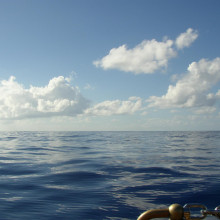
How do marine mammals control their salt intake?
Helen - Well, actually they don't. As far as we can see, they don't drink that much seawater at all. In fact most whales and dolphins and things like that really don't drink seawater at all. They get most of the water they need in their diet from their food because lots of fish are about 60 or 80 percent water. And you can also get lots of water from metabolism, from oxidizing fat, and they have those blubbery layers and it can actually provide them with water. So half the time, they actually keep their mouths shut, but, of course, some does get in when they're eating their food and so on. And sea otters apparently do drink quite a bit of seawater and that could possibly be because they actually eat lots of invertebrates, sea urchins or things like that. They're quite salty and high in protein which means they create lots of urea. To process that salt and urea nitrogen does take a lot of water, So they do drink lots of water and one of the keys, really it comes down to their kidneys. They've got a very different type of kidney to most land animals in that if you look at the human kidney (or most mammals have kind of a kidney-shaped kidney - a sort of single lump with various things going inside) whereas, in fact, cetaceans and seals and things have lots of little bits to their kidneys. They're very complex structures with lobes - thousands of lobes and each one of those is an individual kidney, if you like. So they are actually able to concentrate the fluids in their urine to be stronger than seawater. So they do have that ability but they don't necessarily do it all the time, which is actually quite surprising that they don't have to do that. They actually just don't have that much salt in their system in the first place.Chris - Because one thing that is very often not apparent until perhaps you read a biochemistry book or something is that metabolism itself produces a lot of water. So when you burn sugars, you release enormous amounts of water anyway. So, therefore, some animals are very good at using all that water so their obligatory need to drink is quiet low.Helen - Absolutely and they think when certain seals and sea lions actually go through long periods when they don't eat and they're very much relying on their metabolism and their blubber at that point to provide them with enough water.
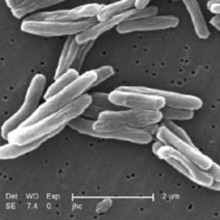
Why is TB contagious?
Chris - Well, tuberculosis is a bacterial infection. It's an infection caused by Mycobacterium tuberculosis. There's also another form called Mycobacterium bovis, which is actually as the name suggests carried by cows but can occasionally get into humans. And people who have TB and specifically open TB, in other words they're actively infected with it, they have TB growing in their lungs, they're infectious. And these bacteria are absolutely tiny. There are many of them and once a person has TB they can remain infected with it for very long periods of time. And about one-third of the world's population is thought to be infected so that's something in the region of two billion people on Earth who've got TB and those numbers are increasing. The death toll because of TB is in the thousands every single day so it's a very major disorder, and it's a very common disorder because it's a very infectious disease. So if you have infectious cases, then you will get onward spread. And it used to be a major problem until we did things like testing for it and then vaccinating. We give people the BCG which is a disabled live bacterium, a mycobacterium which you put into someone and this educates the immune system to help them to react to TB. And this reduces the chances of you getting a serious dose of TB in the future.
32:01 - Open source software
Open source software
with Michael Tiemann, OSI. Darren Strange, Microsoft. Don Marti, OSWC
Helen - You're listening to The Naked Scientists and now it's time to join Laura Soul who's been finding out about the latest developments in technology this month, and she's been looking into the world of open source software.
Laura - This month in technology, we're looking at open source software. That is software that you are free to use, modify, and redistribute yourself. At the moment, most software is proprietary, meaning it is owned by a company. You can't change it and you have to pay to use it. Recently, the alternative; open source software, has been becoming more popular. If you've used internet browsers such as Firefox or Google Chrome then you've been using open source software. I spoke to Michael Tiemann, the President of the Open Source Initiative.
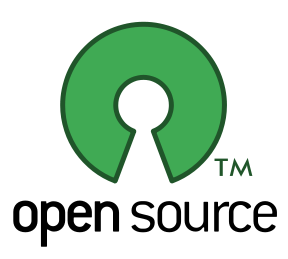 Michael - The idea of open source software was born as people began to look at the way that software developed on the internet was developed differently than software developed in proprietary commercial environments. What people found was that programmers who shared their work and who made their work easily accessible to other people, not just to download but also to read and to modify and to understand. That began to exhibit a degree of innovation and a degree of quality that was completely unpredicted by backers of the proprietary software model.
Michael - The idea of open source software was born as people began to look at the way that software developed on the internet was developed differently than software developed in proprietary commercial environments. What people found was that programmers who shared their work and who made their work easily accessible to other people, not just to download but also to read and to modify and to understand. That began to exhibit a degree of innovation and a degree of quality that was completely unpredicted by backers of the proprietary software model.
Laura - So what are the advantages of using open source?
Michael - The underlying architecture that was designed to be easy for others to work on was a superior way of building software than the traditional proprietary model which was to make things complicated to assume limited access and to assume that only the genius in the Ivory Tower would ever even want to look at the code, so why make it clear?
Laura - It seems the proprietary software still dominates the market. Why do you think this is?
Michael - In the world of information technology, there are many companies who have been accused and many companies who have been adjudicated to be monopolists, and this power of monopoly, which is explained very well in the courts shows that sometimes a monopoly can literally distort free market economics. They can bully the market to force the market to do what they want rather than what the market would freely choose if there were a choice.
Laura - That was Michael Tiemann, President of the Open Source Initiative. There has been news recently of a new open source operating system like Microsoft Windows or MAC OS, that's made by Google and free to download. Don Marti, Chair of the Open Source World Conference, happening in San Francisco in August, told me what effect this would have on the market.
Don - Where the impact is going to be is if PC manufacturers pick up on this Google Chrome OS and start putting it on computers that people can buy at their local electronics store. If you've got a lot of Google Chrome OS being sold to end-users, well, then all the companies that are out there making the printers and webcams and scanners and every device that you might want to plug into a computer are going to say "Well, we better get some Linux compatibility on this thing."
Laura - That was Don Marti, Chair of the Open Source World Conference. Microsoft is probably the most well-known proprietary software company. I spoke to Darren Strange, head of their open source engagement in UK.
Darren - There are many advantages in a proprietary model. There's things in terms of being able to take a holistic view of the whole platform and that enables us to deliver products that are more reliable, they are more secure and they are more consistent in many ways. Microsoft's on a really interesting journey and I think if you look at it for the last 10 years, we've really shifted to being a lot more open to open source. And what we're learning is to be a lot more pragmatic about understanding that we're not competing against open source as a philosophy, that's like competing against the air. We are competing actually against products. So we might compete against Linux. We might compete against other products like Open Office. But in the same way, we also learn to work with those products too, and we're profoundly optimistic about how Microsoft and the open source community can grow together for the benefit of our customers.
Laura - That was Darren Strange from Microsoft Open Source Engagement. Finally, Michael Tiemann explained his hopes for open source in the future.
Michael - I envision a world where more and more companies in the technology world are able to run as largely or fully open source companies. I think that this idea of continuous innovation is precisely what motivates people to join the open source community and I can tell you that it's very exciting to people when they realise that the machine that they boot; all of the source code that controls that machine is available for inspection.
Helen - That was Michael Tiemann and before that Darren Strange and Don Marti, talking to Laura Soul about news of a new open source operating system, Google Chrome OS and how the world of open source software could change in the future.

Could a camera flash move a piece of plastic above it?
Helen - He says he's tried this, actually, when he was a young boy quite a few years ago. And basically he put a flash gun on a flat table and set up a system where he could fire it off when he wanted to. He put a piece of plastic on top of it, then when the flash went off, it moved.Chris - And he's saying how could a flash move the plastic?Helen - How could that work? Any thoughts on that?Chris - I think it's perfectly feasible because a flash discharges quite a lot of energy. If you take a flash gun and look at the nuts and bolts of how it works, basically, what you're doing is using a circuit to charge a very big capacitor. The capacitor then discharges a fairly high voltage, about 300 volts through a gas tube, usually xenon is what is used, and this unleashes enormous amounts of energy very, very quickly, which is why you see this flash of light. But what that also does is to produce lots of heat so what I suspect is going on is that the flash goes off, this unleashes some heat. This heats the surface of the piece of plastic plus it heats the air separating the plastic and the flash bulb. These two things together contribute to both the change of shape of the plastic but, moreover, change of shape of the air. It expands. This may lift up and push the plastic up off the flash a little bit or especially if it's a light piece of plastic or a piece of paper. I did a few simple back-of-the-envelope calculations. If you look at the capacitor in a flash gun, it's about a one millifarad capacitor. It's quite a lot of capacitance and you can calculate how much energy comes out of a capacitor by the equation, E=1/2 CV2 [where E is the energy, C is the capacitance and V is the voltage.]If you put those numbers in with a one millifarad capacitor and you're using a voltage of about 300 volts, that's actually about 45 joules of energy. [ E=1/2 CV2 = 1/2 1x3002 = 1/2 90000 = 45000mJ or 45 J]That would lift a book about 45 metres up in the air, if you think about it. A book weighs about 1 Newton, I suppose, if you had a light or small paperback. So yeah, it's a reasonable amount of work you get out of it. When you do the electrodes on someone's chest to do a cardiac arrest resuscitation, that's about 300 joules, so it's probably about a fifth of the amount you would use to restart someone's heart. It's a reasonable amount of energy I think. So I don't think it's unfeasible.
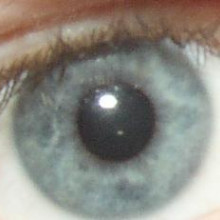
Why does squinting help you to see more clearly? How does it work?
Dave - Okay. The way your eye works in the first place is it has a lens at the front - a lens in the cornea. They act together to focus light onto the back of your eye. Basically, a lens is a curved piece of transparent material. The light goes slightly slower in the lens than in the air so when light hits it at an angle it will slow down and go on the corner. A perfect lens is shaped so as it focuses all of the light from one point to outside your eye to one point on the back of your retina. The problem is as things get closer and further away, you need to change the focus. You need to change the distance. The way your eye does that is by changing the shape of your lens. The problem comes if you're short-sighted or long-sighted. Then your lens isn't the right shape for the length of your eye. And you can't adjust enough to help to see things so things look fuzzy. But the smaller the iris, the smaller an area of lens which light can get through, the less it can go wrong so the less fuzzy, the less the errors are so the less fuzzy the image is. So, basically, the main thing that squinting does is it reduces the area that light can get in through in the same way if you go out on a sunny day things look less fuzzy because your iris closes down. So if you squint you should close down your eye. You let light in through less of the lens and things look less fuzzy
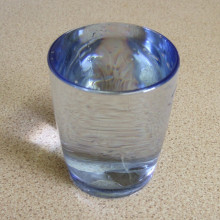
How much water is actually produced by a human on an average day of metabolism?
Dave - Well, I can acknowledge a contribution from our wonderful friend, the internet here. There's a book by Paul Insell, Elaine Turner and Don Ross, Discovering Nutrition. We just had a quick look in there and their stated figure is about a third of a litre per day is the amount of water that your body makes just through metabolising, just by burning sugar because the equation is glucose: C6H12O6. If you burn that using six molecules of oxygen: plus 6 O2, this goes to 6 molecules of carbon dioxide: six CO2 plus 6 H2O, six water molecules, and that all adds up to about a third of a litre a day which is why you get some of the water that you need from actually your own metabolism.
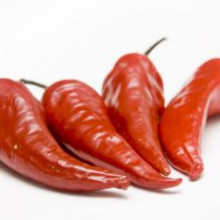
Why do chilli peppers change colour when they go ripe?
We're growing some chilli peppers on our window sill. Actually, my chilli plant got some fungal disease and died though or nearly died. I've managed to resuscitate it but I had to spray something on it. It's says, "Do not use on things you intend to eat," so while I saved the plant, it's now useless because I can't actually eat it. Anyway, we're growing some chilli peppers on our window sill. For ages they've been green but suddenly they're going beautiful red and yellow colours. I understand the process why most plants are green but why do the peppers turn red and yellow? What's the point in that?Helen - Actually, I'm growing my own chilli peppers too, failing too as well. So if you've got any tips on how to do it better, I'd love to hear from you. But, well if you think about it, it's kind of a two-sided question, really. First of all, why does any kind of fruit or anything that might be eaten change into a bright red colour and usually that's if it's ripe and ready to go, it's advertising itself to be eaten by a disperser. An animal of some sort is going to come along, have a nibble, eat it, take the seeds in its stomach and release them somewhere else in the faeces to help disperse this plant. That's okay if you're a nice tasty thing like a tomato. They start out green and they don't want to be eaten before they're nice and ready, before the seeds have actually developed enough. So they will later on turn to be red and there you go. That's why they turn red, but why do chillies turn red? Do they actually want to be eaten given that they're so spicy? Do animals actually like to eat chillies? Well, there's lots of theories about why chillies evolve to have such spiciness and capsaicin is the chemical that actually makes your tongue burn when you have a mouthful of chilli, and I love it as well. And a guy called Josh Tewksbury, a scientist in the University of Washington who spent a lot of his time looking into this question of how spicy chillies evolved, why they evolved. What's the purpose of them? He's been out in the Bolivian and Peruvian jungles where we think - well, sorry, the rainforest, the dry mountainous areas, actually not rainforest, where we think these chillies first evolved and he's found some really interesting things out. So, we think that it could actually be that mammals are no good at eating chillies because they actually crunch them up. They're seed predators. That's not much use to the chilli plants; their seeds get destroyed that way. But maybe birds are the ones that the chillies are trying to attract because birds usually just swallow down the seeds whole and they don't actually get affected by the chilli and they've watched to see. There are natural variations in the amount of capsaicin you get in plants within one population of chillies. They went out and looked and they saw that mammals don't like to eat the ones where there's lots of capsaicin in the plants. But birds don't mind, they would just go for any of them.Chris - I think, they actually lack the receptor that the capsaicin locks on to on the nerve fibres.Helen - Right, there you go.Chris - So they can't detect it.Helen - That as well.Chris - Because one suggestion we did have for people who keep chickens and are fed up with rats eating the chicken food is that you put loads of curry powder in with the chicken food and the chickens don't notice the curry powder because they're insensitive to the effect of capsaicin.Helen - There you go.Chris - But the rats do and the other benefit of that is that you get a sort of premarinated chicken, so when you come to eat it, it's already nice and currified.Helen - Super! Super! It's also could be that it could deters fungal attack and that in fact having more capsaicin in the chilli plants, in their seeds helps to avoid fungus coming along and destroying the seeds. Maybe it's attracting birds that's why chillies are red but we've been doing it for an awfully long time, at least 6000 B.C. we think that chillies were being cultivated.Chris - With good reason, they're fantastically tasty.And we had a comment from Judith in Northhampton who said that capsaicin powder can be used to stop things eating your chicken food. She uses the same trick to stop the squirrels in nicking her bird feed.

How should I align my laundry with the wind?
Dave - I would have said you probably want it across the wind because if the wind's running along your laundry then any moisture evaporates and the front end of the laundry is then going to reduce the evaporation further on. And if you're going across it then you get lots of turbulence so the air will get to the back fine because it will just go over the top and swirl in the back. If anyone has any bright ideas then I'd love to hear them.Chris - Yes, I would suggest using a tumble dryer inside which is guaranteed to work unlike the washing I know in this country.Helen - Oh, Chris, how about the sunshine? Come on, think of the environment. I hang my washing outside.Chris - Indeed.Helen - In between the rain showers.
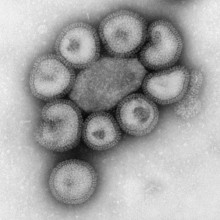
How come we suddenly have this new medication, Tamiflu, for swine flu, so quickly?
Chris - Well, the answer is we've actually had Tamiflu, Oseltamivir, and there's another version of that which works in the same way but is made by a rival company and that's called Relenza Zanamivir. These agents were quite carefully designed. They were processed on what's called rational drug design actually. What they do is to target a particle on the surface of a flu virus, which is called the neuraminidase. This is an enzyme that sits down on the surface of the virus. It behaves a bit like a machete and when a virus infects a cell, it tries to bud off or get away from the cell that it's grown in, and in order to do that, it needs to make sure that it doesn't get stuck on to the surface of the cell and also get stuck in any of the mucus, which is on the lining of the airway. And this enzyme cuts the virus adrift and helps it to get free. The way Tamiflu works is by blocking up that enzyme so the virus can't escape from the cell that it's been growing in and this means that it finds it much harder to spread to other cells and this effectively confines the virus to barracks. And so, the infection progresses more slowly, it doesn't infect many other people. It doesn't infect so many other cells in the same person and, therefore, the immune system has a better opportunity to try and curtail the infection a little bit.
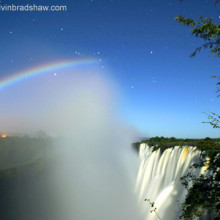
What determines actual shape of rainbow?
Dave - Okay. The rainbow is actually always the same shape: it's always a circle.
The way a rainbow is formed is that, when the light goes into a raindrop, it kind of reflects around the back [of the raindrop] and, as it goes in and goes out, it refracts - it bends - because light goes slower in water than it does in air.
Different colours or wavelengths of light refract by slightly different amounts, so the light comes out of the raindrop at slightly different angles depending on its colour.
A raindrop is circularly symmetric, so the refraction means that you get a cone of different colours of light coming out of the drop.
So, if you look at the raindrop from certain different directions, it looks different colours. If you have a whole sky full of raindrops at different angles you see different colours depending on the direction you are looking in. You get a circular rainbow exactly opposite the Sun. If the sun is high in the sky, you just see the top of the circle and the rainbow looks flat.
If the sun is low, you can see a full semicircle; and if you are in a plane, you can see a full circular rainbow.
Chris - That makes sense. And when you see a second rainbow, that's presumably where it's gone into the raindrop bounced off the front of the raindrop, gone to the back again and come out front. So, there are two journeys and that's why you get a second rainbow around the first?
Dave - It's doing more exciting things inside the raindrop!

How do tattoos last for so long?
We put this to Neil Walker, consultant dermatologist in Oxford...
Tattoos by definition are permanent marks produced on the skin by the injection of the material by a puncturing. As a dermatologist, I see a variety of tattoos, not any of those which have been applied by a so-called tattoo artist, either a professional or amateur, sober or drunk.
Occasionally, I see people who've had a black kind of tattoo, where a dye called PPD is used, which can cause nasty skin reactions. Appropriately applied henna tattoo is not a tattoo at all. Rather, it's a drying process using the paste to produce a design in the dead outer layers of the skin. The design fades as the skin regenerates and that is one of clues as to why tattoos applied by puncturing are permanent.
Our skin is continually regenerating as the outer layers or epidermis grows from basal cells at the bottom to a dead hole-y layer at the top over a period of six to eight weeks. Pigments implanted beneath the growing layer are in the dermis or supporting layer of the skin and are not removed by the natural process of skin turnover.
The body recognises pigment granules as foreign material and there are cells whose function is to remove such material by engulfing them and transporting it to the lymph glands. These cells are unable to engulf pigment granules every certain size and, therefore, the body seem to surround them at their microscopic level by a thin layer of fibrous or scar tissue. And they become permanently trapped in the dermis.
The removal process continues slowly and tattoos may fade to a degree over time with different colours fading at different rates depending on the particle size of the pigment. In summary, tattoos are permanent because pigment particles are injected under the growing layer of the skin and the body's mechanisms for dealing with foreign materials can't remove the particles over a certain size.
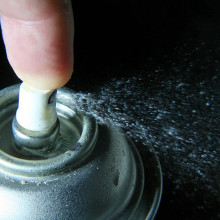
What does spray paint contain that makes it burn so well?
Chris - Well, the answer is down to two things. One is the propellant, the stuff that makes the paint come out of the tin in the first place. That's usually a gas like butane or propane. Those are the common propellants also used in deodorant, which is why deodorants are so flammable. The other thing that these spray paints contain is paint - the paint molecules themselves are hydrocarbon-based, so they're very flammable and there's methanol in there too.
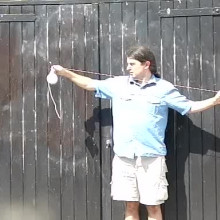










Comments
Add a comment